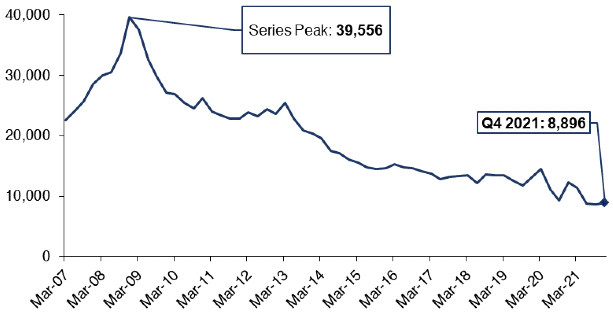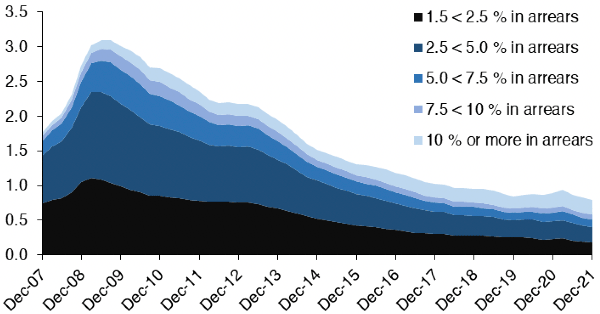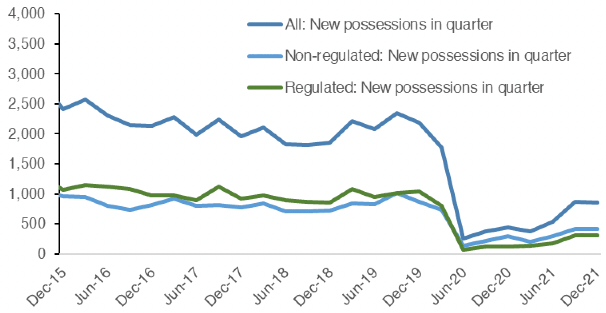Scottish Housing Market Review: Q1 2022
Summary of the latest Scottish housing market data.
This document is part of a collection
Lending To Homebuyers: Arrears and Possessions
Arrears
There were 8,896 regulated mortgages that went into arrears across the UK in Q4 2021, a decrease of 27.5% (-3,371) on Q4 2020. As shown in Chart 4.9, following a peak of 39,556 in Q4 2008 during the financial crisis, there has been a declining trend in the number of regulated mortgages entering arrears, which has continued despite the impact of Covid-19. It should be noted that Covid-19 payment holidays were not classified as technical arrears, and thus are not reflected in these figures; however, even though these payment holidays came to the end in April 2021, this has not result in an increase in arrears so far. (Source: FCA)

Source: FCA
The share of lenders' outstanding regulated mortgage balances that were in arrears stood at 0.80% at the end of Q4 2021. This has remained broadly stable during the pandemic, with arrears at 0.89% at the end of Q4 2020. Chart 4.10 plots the share of lenders' outstanding balances that were in arrears by degree of severity. Arrears reported in the FCA MLAR data relate only to loans where the amount of actual arrears is 1.5% or more of the borrower's current loan balance.

Source: FCA
UK Finance data show that there were 6,010 buy-to-let mortgages in arrears of 2.5% or more of the outstanding balance across the UK in Q4 2021. This is down by an annual 0.8% (-50). This is still low relative to the period of the 2008 financial crisis. The number of buy-to-let mortgages in arrears of 2.5% or more as a percentage of the total number of buy-to-let mortgages was 0.30% as at Q4 2021, roughly equal to Q4 2020 (0.27%).
Possessions and evictions
The FCA published finalised guidance for UK mortgage lenders in March 2021, outlining that possessions could be enforced from 1 April 2021 but this must be in accordance with FCA guidance and regulatory requirements, which mean that possessions should only take place as a last resort, if all other reasonable attempts to resolve the situation have failed. In Scotland, a ban on the enforcement of eviction orders in areas in Levels 3 and 4 ended on the 30 September 2021.
Chart 4.11 shows that despite restrictions on possessions being lifted, there were only 435 new regulated mortgage possessions across the UK in Q4 2021, a decrease relative to Q3 2021 of 18 (-4.0%). While the level of possessions has increased since restrictions were lifted, they are still significantly lower than pre-pandemic levels, with possessions down by 884 (67.0%) relative to Q4 2019. It can also be seen that regulated and non-regulated possessions moved in a similar direction over the recent period.

Source: FCA
The Coronavirus (Extension and Expiry) (Scotland) Act, passed on 24 June 2021, extended additional protections for tenants to 30 March 2022: in particular, measures increasing the notice period for social and private evictions to 6 months in most cases, giving the First Tier Tribunal discretion when considering all grounds for eviction in the private rented sector, and requiring private landlords seeking eviction on rent arrears grounds to follow Pre-Action Requirements.
The Scottish Government announced in June 2021 a £10 million tenant grant fund for councils to support tenants struggling to pay their rent as a direct result of Covid-19 and who are at risk of eviction, reporting on the fund is available Tenant Grant Fund monitoring report: January 2022. This is part of a package of measures available to local authorities to prevent homelessness, alongside Discretionary Housing Payments and advice on maximising income. The grants come on top of the Scottish Government's £10 million Tenant Hardship Loan Fund.
The Coronavirus (Recovery and Reform) (Scotland) Bill, introduced to Parliament on 25 January, seeks to embed reforms in Scotland's public services and justice system that, though necessitated by the Covid pandemic, have delivered improvements for service users and improved efficiency.
Part 4 of the Bill relates to eviction from properties in the private rented sector and proposes that in relation to the tenancy types set out in the Bill, a tribunal will not have to automatically evict people. The tribunal will, however, still be able to grant an eviction if it considers it reasonable. Part 4 also sets up a "pre-action protocol". This protocol is something landlords can follow before starting eviction proceedings. Whether landlords have or have not followed this protocol will be considered by a tribunal in deciding whether to order an eviction in cases where late or non-payment of rent is the reason why the landlord is seeking an eviction.
Contact
Email: William.Ellison@gov.scot
There is a problem
Thanks for your feedback